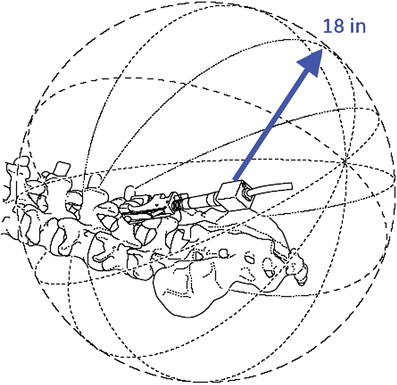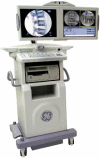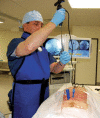Minimally invasive percutaneous transpedicular screw fixation: increased accuracy and reduced radiation exposure by means of a novel electromagnetic navigation system
- PMID: 21153669
- PMCID: PMC3040822
- DOI: 10.1007/s00701-010-0882-4
Minimally invasive percutaneous transpedicular screw fixation: increased accuracy and reduced radiation exposure by means of a novel electromagnetic navigation system
Abstract
Background: Minimally invasive percutaneous pedicle screw instrumentation methods may increase the need for intraoperative fluoroscopy, resulting in excessive radiation exposure for the patient, surgeon, and support staff. Electromagnetic field (EMF)-based navigation may aid more accurate placement of percutaneous pedicle screws while reducing fluoroscopic exposure. We compared the accuracy, time of insertion, and radiation exposure of EMF with traditional fluoroscopic percutaneous pedicle screw placement.
Methods: Minimally invasive pedicle screw placement in T8 to S1 pedicles of eight fresh-frozen human cadaveric torsos was guided with EMF or standard fluoroscopy. Set-up, insertion, and fluoroscopic times and radiation exposure and accuracy (measured with post-procedural computed tomography) were analyzed in each group.
Results: Sixty-two pedicle screws were placed under fluoroscopic guidance and 60 under EMF guidance. Ideal trajectories were achieved more frequently with EMF over all segments (62.7% vs. 40%; p = 0.01). Greatest EMF accuracy was achieved in the lumbar spine, with significant improvements in both ideal trajectory and reduction of pedicle breaches over fluoroscopically guided placement (64.9% vs. 40%, p = 0.03, and 16.2% vs. 42.5%, p = 0.01, respectively). Fluoroscopy time was reduced 77% with the use of EMF (22 s vs. 5 s per level; p < 0.0001) over all spinal segments. Radiation exposure at the hand and body was reduced 60% (p = 0.058) and 32% (p = 0.073), respectively. Time for insertion did not vary between the two techniques.
Conclusions: Minimally invasive pedicle screw placement with the aid of EMF image guidance reduces fluoroscopy time and increases placement accuracy when compared with traditional fluoroscopic guidance while adding no additional time to the procedure.
Figures





Similar articles
-
Electromagnetic field-based image-guided spine surgery part two: results of a cadaveric study evaluating thoracic pedicle screw placement.Spine (Phila Pa 1976). 2003 Sep 1;28(17):E351-4. doi: 10.1097/01.BRS.0000086822.76638.76. Spine (Phila Pa 1976). 2003. PMID: 12973162
-
Comparison of the percutaneous screw placement precision of isocentric C-arm 3-dimensional fluoroscopy-navigated pedicle screw implantation and conventional fluoroscopy method with minimally invasive surgery.J Spinal Disord Tech. 2009 Oct;22(7):468-72. doi: 10.1097/BSD.0b013e31819877c8. J Spinal Disord Tech. 2009. PMID: 20075808
-
Electromagnetic field-based image-guided spine surgery part one: results of a cadaveric study evaluating lumbar pedicle screw placement.Spine (Phila Pa 1976). 2003 Sep 1;28(17):2013-8. doi: 10.1097/01.BRS.0000087851.51547.00. Spine (Phila Pa 1976). 2003. PMID: 12973150
-
Accuracy of K-Wireless Insertion of Percutaneous Pedicle Screws Using Computer-Assisted Spinal Navigation: A Systematic Review and Single-Center Experience.World Neurosurg. 2020 Jun;138:e267-e274. doi: 10.1016/j.wneu.2020.02.079. Epub 2020 Feb 24. World Neurosurg. 2020. PMID: 32105880
-
The accuracy of pedicle screw placement using intraoperative image guidance systems.J Neurosurg Spine. 2014 Feb;20(2):196-203. doi: 10.3171/2013.11.SPINE13413. Epub 2013 Dec 20. J Neurosurg Spine. 2014. PMID: 24358998 Review.
Cited by
-
Use of a quantitative pedicle screw accuracy system to assess new technology: Initial studies on O-arm navigation and its effect on the learning curve of percutaneous pedicle screw insertion.SAS J. 2011 Sep 1;5(3):57-62. doi: 10.1016/j.esas.2011.04.001. eCollection 2011. SAS J. 2011. PMID: 25802669 Free PMC article.
-
Tracked ultrasound snapshots in percutaneous pedicle screw placement navigation: a feasibility study.Clin Orthop Relat Res. 2013 Dec;471(12):4047-55. doi: 10.1007/s11999-013-3239-5. Epub 2013 Aug 17. Clin Orthop Relat Res. 2013. PMID: 23955194 Free PMC article.
-
Simultaneous navigated cervico-thoracic and thoraco-lumbar fixation.Eur Spine J. 2018 Jul;27(Suppl 3):318-322. doi: 10.1007/s00586-017-5233-1. Epub 2017 Jul 24. Eur Spine J. 2018. PMID: 28741148
-
Surgical Precision and Efficiency of a Novel Electromagnetic System Compared to a Robot-Assisted System in Percutaneous Pedicle Screw Placement of Endo-LIF.Global Spine J. 2023 Jun;13(5):1243-1251. doi: 10.1177/21925682211025501. Epub 2021 Sep 14. Global Spine J. 2023. PMID: 34519243 Free PMC article.
-
Posterior spinal decompression, stabilization and arthrodesis in Nigerian adults: Profile and outcome.Niger Med J. 2012 Jan;53(1):42-6. doi: 10.4103/0300-1652.99832. Niger Med J. 2012. PMID: 23271844 Free PMC article.
References
-
- Austin MS, Vaccaro AR, Brislin B, Nachwalter R, Hilibrand AS, Albert TJ. Image-guided spine surgery: a cadaver study comparing conventional open laminoforaminotomy and two image-guided techniques for pedicle screw placement in posterolateral fusion and nonfusion models. Spine. 2002;27:2503–2508. doi: 10.1097/00007632-200211150-00015. - DOI - PubMed
Publication types
MeSH terms
LinkOut - more resources
Full Text Sources
Medical

